
This Hubble image shows a pair of massive stars, WR 25 and Tr16-244, located within the open cluster Trumpler 16. This cluster is embedded within the Carina Nebula, an immense cauldron of gas and dust that lies approximately 7500 light-years from Earth in the constellation of Carina, the Keel. WR 25 is the brightest, situated near the centre of the image. The neighbouring Tr16-244 is the third brightest, just to the upper left of WR 25. The second brightest, to the left of WR 25, is a low mass star located much closer to Earth than the Carina Nebula.
Credits: NASA, ESA and Jesús Maíz Apellániz (Instituto de Astrofísica de Andalucía, Spain)

In Tr16-244 two of the stars are so close to each other that they look like a single object, but Hubble's Advanced Camera for Surveys shows them as two.
Credits: NASA, ESA and Jesús Maíz Apellániz (Instituto de Astrofísica de Andalucía, Spain)

WR 25 and Tr16-244, on the left of the image, are located within the open cluster Trumpler 16. This cluster is embedded within the Carina Nebula, an immense cauldron of gas and dust that lies approximately 7500 light-years from Earth in the constellation of Carina, the Keel.
Credits: NASA, ESA and Jesús Maíz Apellániz (Instituto de Astrofísica de Andalucía, Spain)

Astronomers have used two different telescopes simultaneously to study the violent flares from the supermassive black hole in the centre of the Milky Way. They have detected outbursts from this region, known as Sagittarius A*, which reveal material being stretched out as it orbits in the intense gravity close to the central black hole.
The team of European and US astronomers used ESO's Very Large Telescope (VLT) and the Atacama Pathfinder Experiment (APEX) telescope, both in Chile, to study light from Sagittarius A* at near-infrared wavelengths and the longer submillimetre wavelengths respectively. This is the first time that astronomers have caught a flare with these telescopes simultaneously. The telescopes' location in the southern hemisphere provides the best vantage point for studying the Galactic Centre.
"Observations like this, over a range of wavelengths, are really the only way to understand what's going on close to the black hole," says Andreas Eckart of the University of Cologne, who led the team.
Sagittarius A* is located at the centre of our own Milky Way Galaxy at a distance from Earth of about 26 000 light-years. It is a supermassive black hole with a mass of about four million times that of the Sun. Most, if not all, galaxies are thought to have a supermassive black hole in their centre.
"Sagittarius A* is unique, because it is the nearest of these monster black holes, lying within our own galaxy," explains team member Frederick K. Baganoff of the Massachusetts Institute of Technology (MIT) in Cambridge, USA. "Only for this one object can our current telescopes detect these relatively faint flares from material orbiting just outside the event horizon."

Astronomers have long puzzled over why a small, nearby, isolated galaxy is pumping out new stars faster than any galaxy in our local neighborhood.
Now NASA's Hubble Space Telescope has helped astronomers solve the mystery of the loner starburst galaxy, called NGC 1569, by showing that it is one and a half times farther away than astronomers thought.
The extra distance places the galaxy in the middle of a group of about 10 galaxies centered on the spiral galaxy IC 342. Gravitational interactions among the group's galaxies may be compressing gas in NGC 1569 and igniting the star-birthing frenzy.
"Now the starburst activity seen in NGC 1569 makes sense, because the galaxy is probably interacting with other galaxies in the group," said the study's leader, Alessandra Aloisi of the Space Telescope Science Institute in Baltimore, Md., and the European Space Agency. "Those interactions are probably fueling the star birth."
The farther distance not only means that the galaxy is intrinsically brighter, but also that it is producing stars two times faster than first thought. The galaxy is forming stars at a rate more than 100 times higher than in the Milky Way. This high star-formation rate has been almost continuous for the past 100 million years.
Discovered by William Herschel in 1788, NGC 1569 is home to three of the most massive star clusters ever discovered in the local universe. Each cluster contains more than a million stars.
"This is a prime example of the type of massive starbursts that drive the evolution of galaxies in the distant and young universe," said team member Roeland van der Marel of the Space Telescope Science Institute. "Starburst galaxies can only be studied in detail in the nearby universe, where they are much rarer. Hubble observations of our galactic neighborhood, including this study, are helping astronomers put together a complete picture of the galaxies in our local universe. Put the puzzle pieces in the right place, as for NGC 1569, and the picture makes much more sense."

These images of three galaxies from the Galaxy Zoo (top) and STAGES surveys (bottom) show examples of how the newly discovered population of red spiral galaxies on the outskirts of crowded regions in the Universe may be a missing link in our understanding of galaxy evolution. At left, both surveys find examples of normal spiral galaxies displaying all the hallmarks of youth: blue in colour, they are disk-like in structure. The obvious spiral arms host knotty structures where large numbers of hot young stars are being born. On the right are examples of typical rounded balls of stars known as elliptical galaxies. The reddish colour indicates that their stars are mostly old. With no gas left to use as fuel to form any more, they are old, dead and red In the centre are examples of the new "red spiral" galaxy found in large numbers by both the STAGES and Galaxy Zoo collaborations. While still disk-like and recognizably spiral in shape, their spiral arms are smoother. Furthermore, their colour is as red as the ellipticals. Astronomers from both teams believe these red spirals are objects in transition, where star formation has been shut off by interactions with the environment. (Credit: STAGES image credit: Marco Barden, Christian Wolf, Meghan Gray, the STAGES survey; STAGES image from Hubble Space Telescope, colour from COMBO-17 survey; Galaxy Zoo image credit: Sloan Digital Sky Survey)

Binary Star Explosion Inside Nebula Challenges Star Theory
ScienceDaily (Nov. 25, 2008) The explosion of a binary star inside a planetary nebula has been captured by a team led by UCL (University College London) researchers an event that has not been witnessed for more than 100 years. The study, published in Astrophysical Journal Letters, predicts that the combined mass of the two stars in the system may be high enough for the stars to eventually spiral into each other, triggering a much bigger supernova explosion.
A planetary nebula is an astronomical object consisting of a glowing shell of gas and plasma formed by many stars as they approach the end of their lives, while a nova is a cataclysmic nuclear explosion caused by the accretion of hydrogen onto the surface of a nearly-dead white dwarf star in a close binary.
Dr Roger Wesson, UCL Physics and Astronomy, says: At the ends of their lives, some stars undergo nova explosions, caused by nuclear reactions on their surface. In August 2007, one such exploding star was discovered in a part of the sky that had serendipitously been observed by us only a few weeks previously. The pre-explosion images showed that this particular star was surrounded by a planetary nebula.
Although several novae are discovered each year in our Galaxy, this is only the second time that a nova has been seen inside a planetary nebula, the first being over 100 years ago. Now, the light flash from the explosion is passing through and illuminating the surrounding nebula. This object poses a major challenge to current theories of how stars evolve and could be a Rosetta Stone in understanding some aspects of the lives of stars.
The pre-explosion images were taken as part of the Isaac Newton Telescope Photometric HAlpha Survey (IPHAS), the first digital survey of the Milky Way in visible light, and the most comprehensive yet in the light emitted by hydrogen (the most abundant element in the universe).
The star which erupted was a nova, an event caused when matter is transferred from one star in a close binary system onto its companion, eventually triggering a runaway thermonuclear explosion. The nebula surrounding this nova is a planetary nebula, which must have formed during an earlier phase in the binary star's existence, when the outer layers of one of the companions were expelled. Only one previous nova has been seen to occur inside a planetary nebula Nova Persei in 1901. The opportunity to watch in detail as the nova flash interacts with the nebula is a first in astronomy.

Cosmic Ray 'Hot Spots' Bombarding Earth With Cosmic Rays
ScienceDaily (Nov. 24, 2008) A Los Alamos National Laboratory cosmic-ray observatory has seen for the first time two distinct hot spots that appear to be bombarding Earth with an excess of cosmic rays. The research calls into question nearly a century of understanding about galactic magnetic fields near our solar system.
Joining an international team of collaborators, Los Alamos researchers Brenda Dingus, Gus Sinnis, Gary Walker, Petra Hüntemeyer and John Pretz published the findings November 25 in Physical Review Letters.
The source of cosmic rays has been a 100-year-old problem for astrophysicists, Pretz said. With the Milagro observatory, we identified two distinct regions with an excess of cosmic rays. These regions are relatively tiny bumps on the background of cosmic rays, which is why they were missed for so long. This discovery calls into question our understanding of cosmic rays and raises the possibility that an unknown source or magnetic effect near our solar system is responsible for these observations.
Cosmic rays are high-energy particles that move through our Galaxy from sources far away. No one knows exactly where cosmic rays come from, but scientists theorize they might originate from supernovaemassive stars that explode from quasars or perhaps from other exotic, less-understood or yet-to-be-discovered sources within the universe.

This composite image shows the hot gas around the elliptical galaxy M84 in an X-ray image (blue) and a radio image (red). The bubbles (some visible in the hot gas) were generated by jets coming out of M84's central black hole. The top bubble (blue) is bursting and the hot relativistic gas, shown in red, is spilling out. Credit: X-ray (NASA/CXC/MPE/A.Finoguenov et al.); Radio (NSF/NRAO/VLA/ESO/R.A.Laing et al); Optical (SDSS)

Strange weather on the icy dwarf planet Eris could be causing changes that scientists are now seeing at the methane-ice surface of this distant object in our solar system.
Eris is the largest known solar-system object beyond the orbit of Neptune. It is larger than Pluto, with a diameter of ranging somewhere between about 1,490 miles and 1,860 miles (2,400 km and 3,000 km).
A team of researchers examined data on Eris collected from the MMT Observatory in Arizona. They specifically looked at concentrations of methane ice based on light-reflection and absorption information.
Their results show possibly nitrogen ice mixed in with the methane ice covering Eris' surface. And the relative amount of nitrogen ice increases with depth into the ice, they found.
Here's what the researchers think is happening:
Currently, Eris is at its farthest distance to the sun, called aphelion, along its about 560-year orbit, meaning the planet is nearly 100 astronomical units (AU) from the sun, or about 9 billion miles (14 billion km). Along its orbit, Eris sweeps as close as 38 AU to the sun when at perihelion.
Due to Eris' tilt, a different hemisphere faces the sun when at perihelion and aphelion.
On the sunlit hemisphere or pole at perihelion, lots of sublimation would have occurred to turn nitrogen into gas. (Sublimation is the process of ice turning to gas while skipping the liquid phase.) This gas would build up in the atmosphere likely a very thin one around such a small object to increase the pressure and drive winds toward the shaded pole.
Nitrogen ice turns into a gas at cooler temperatures and so there would be more nitrogen gas in the atmosphere compared with methane. Then, at the shaded pole, also called the winter hemisphere, the gases would condense into snow-like or dew-like material that would fall onto Eris' surface as nitrogen ice.
As Eris moved closer and closer to the sun, this same process would occur for methane, with methane sublimating on the sunlit hemisphere and falling as methane ice on the shaded pole.
As the winds continued to blow from the sunlit side to the shaded hemisphere (as summer progressed on the sunlit side), nitrogen would be depleted. And so relatively more methane would whoosh over to the shaded side and fall as methane ice.
The pole the researchers observed had been shaded for years while Eris was at perihelion. That same pole is now facing the sun and has been for decades to centuries, the researchers say.
Saturn
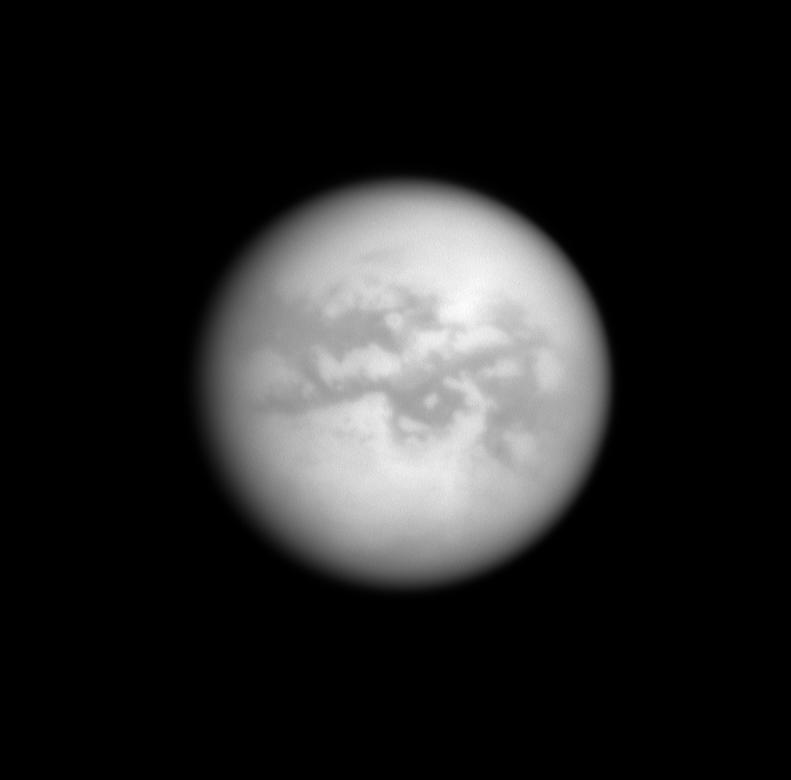
The Cassini spacecraft looks through Titan's thick atmosphere to reveal bright and dark terrains on the Saturn-facing side of the planet's largest moon. North is up.
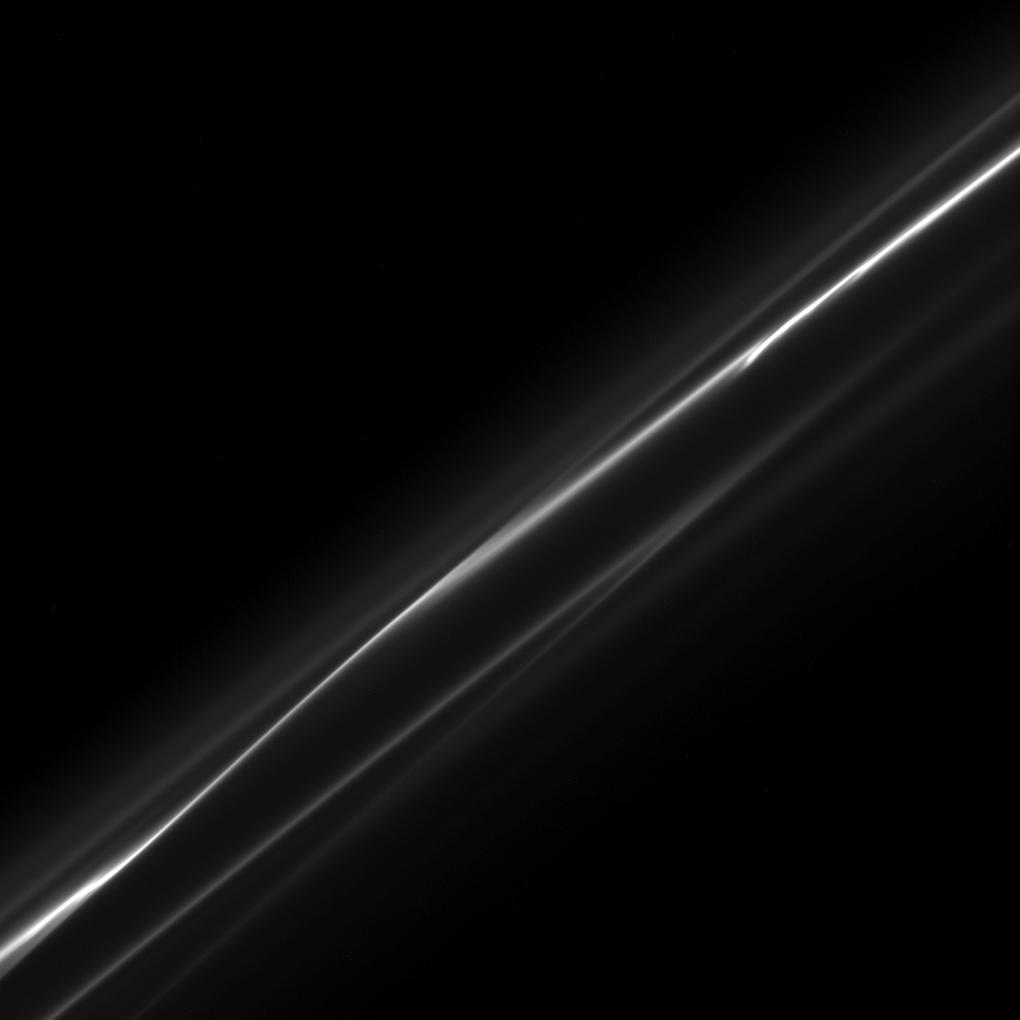
The ever-changing F ring appears as wisps of smoke in this image taken downstream of the shepherd moon, Prometheus.
The image was taken in visible light with the Cassini spacecraft narrow-angle camera on Oct. 23, 2008 at a distance of approximately 437,000 kilometers (272,000 miles) from Saturn and at a Sun-Saturn-spacecraft, or phase, angle of 89 degrees. Image scale is 2 kilometers (1 mile) per pixel.
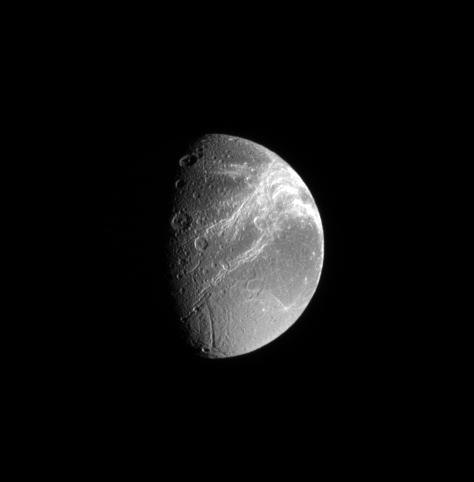
Dione's defining feature, the fractures on its trailing side, shine brilliantly in this Cassini spacecraft view.
The view was acquired from a position 33 degrees south of the moon's equator. Lit terrain seen here is on the trailing side of Dione (1,123 kilometers, or 698 miles across). North is up and rotated 8 degrees to the right.
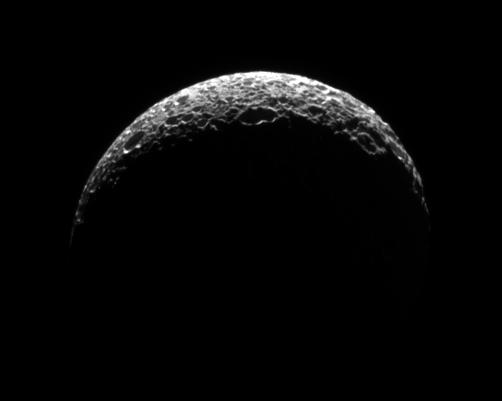
Mimas's lit crescent has the appearance of a golf ball thanks to its heavily cratered surface.
The image was taken with the Cassini spacecraft narrow-angle camera on Oct. 24, 2008 using a spectral filter sensitive to wavelengths of infrared light centered at 752 nanometers. The view was obtained at a distance of approximately 189,000 kilometers (117,000 miles) from Mimas and at a Sun-Mimas-spacecraft, or phase, angle of 136 degrees. Image scale is about 1 kilometer (3,707 feet) per pixel.

Scientists continue to search for the cause of the geysers on Saturn's moon Enceladus. The geysers are visible as a large plume of water vapor and ice particles escaping the moon. Inside the plume are jets of dust and gas. What causes and controls the jets is a mystery. The Cassini spacecraft continues to collect new data to look for clues.
At the heart of the search is the question of whether the jets originate from an underground source of liquid water. Some theories offer models where the jets could be caused by mechanisms that do not require liquid water. Painstaking detective work by Cassini scientists is testing the possibilities to get closer to an answer.
What generates Enceladus' jets is a burning question in planetary science, because if liquid water is involved, Enceladus would be shown to have everything it needs, in theory, to provide a habitable environment.
One recent model offered the possibility that the jets could be violent bursts of volatile ices freshly exposed to space when Saturn's tidal forces would open vents inside the "tiger stripe" region of the moon's south pole.
New Cassini findings reported in the Nov. 27 issue of the journal Nature, however, cast doubt on that hypothesis. When Enceladus is farther away from Saturn, the theory goes, the vents would compress, reducing or shutting off the jets.
"Our observations do not agree with the predicted timing of the faults opening and closing due to tidal tension and compression," said JPL scientist Candice Hansen of Cassini's ultraviolet imaging spectrograph team.
At the same time, Hansen said, the new findings support at least one theory that attributes the jets to a liquid water source inside Enceladus.
Mars
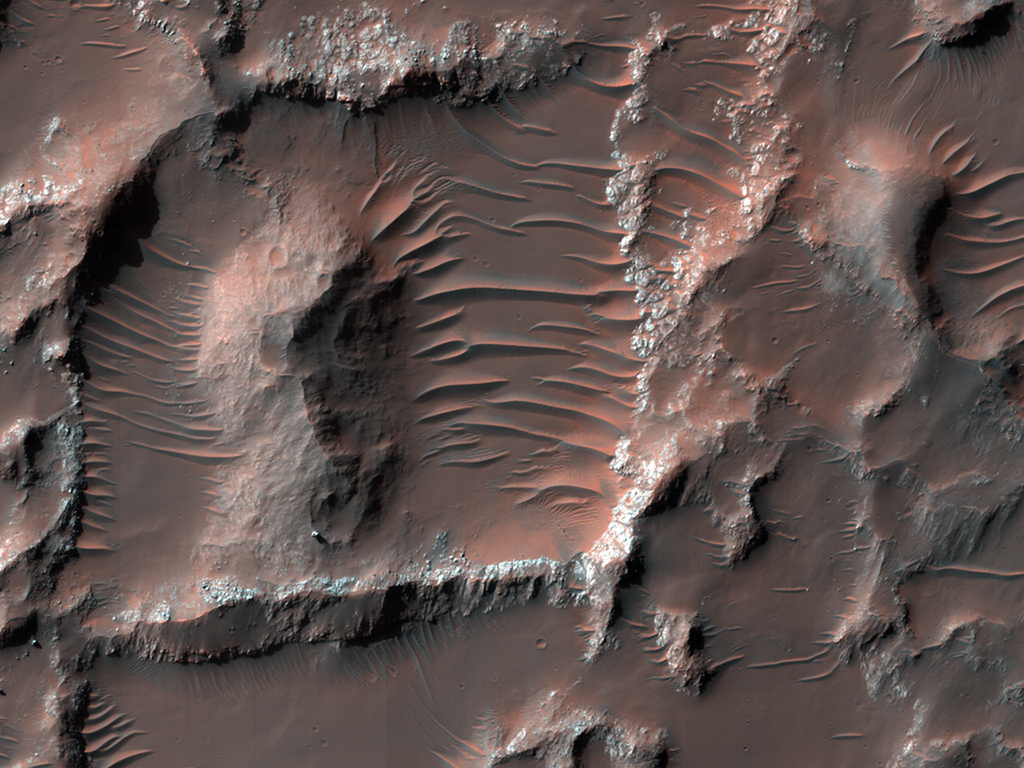
This observation covers the Martian surface just to the east of the 150 kilometer-diameter Holden Crater in southwestern Margaritifer Terra.
The image reveals a very complex terrain, with what appear to be very blocky or polygonally fracture materials interspersed with other materials also standing in relatively high local relief. The entire surface appears etched and the blocky or fracture materials may lie on top of the sequence.
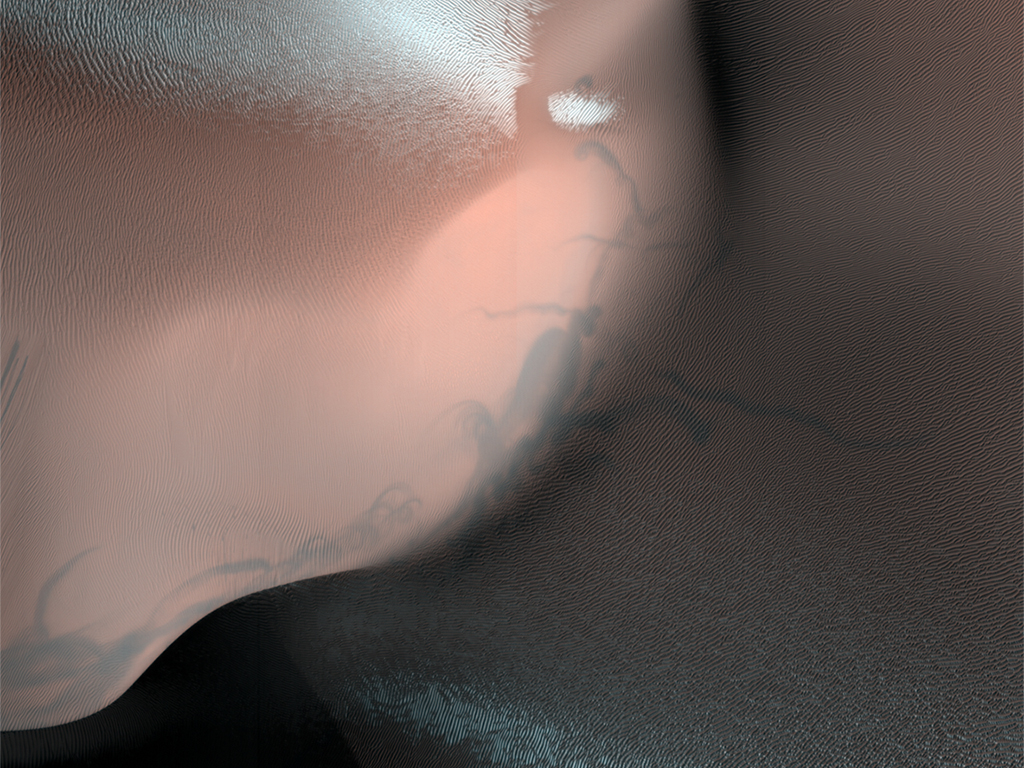
One of the most important processes on present-day Mars is wind. Aeolian (wind-related) features are found in most regions of the planet. This image shows a diverse array of such features: large dunes, small ripples, and dust-devil tracks (the dark, arcing structures on the dunes).
Dust devils form in many parts of Mars, but they are often particularly distinct on sand dunes. One possibility is that the dust devils dislodge a small amount of fine dust, making the color of dark sand more prominent.
Ripples of wind-blown sand form regular patterns. In the simplest case, wind blowing in a constant direction creates evenly spaced straight ripples at right angles to the wind. More complex wind patterns create more complex ripples, and in this scene variations from linear to polygonal to checkerboard patterns are visible.
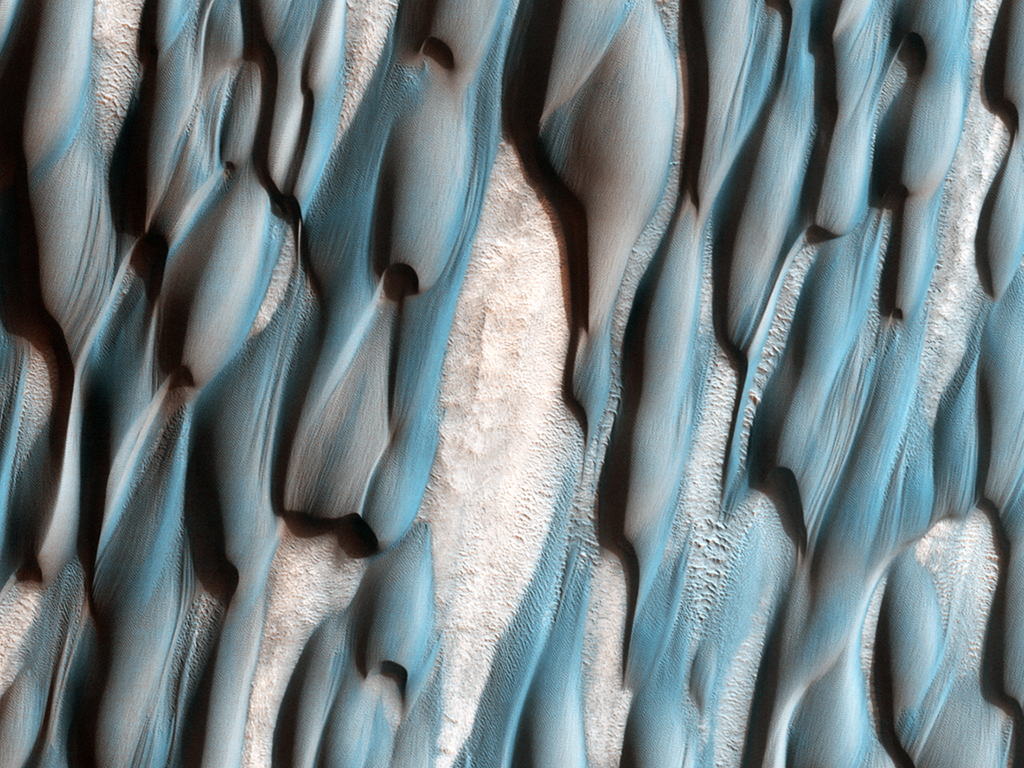
This enhanced-color close-up (1.2 kilometer across, 0.75 miles) shows an example of dunes in Abalos Undae.
The Abalos Undae dune field stretches westward, away from a portion (Abalos Colles) of the ice-rich north polar layered deposits that is separated from the main Planum Boreum dome by two large chasms. These dunes are special because their sands may have been derived from erosion of the Rupes Tenuis unit (the lowest stratigraphic unit in Planum Boreum, beneath the icier layers) during formation of the chasms. Some researches have argued that these chasms were formed partially by melting of the polar ice.
The enhanced color data illuminate differences in composition. The dunes appear blueish because of their basaltic composition, while the reddish-white areas are probably covered in dust. Upon close inspection, tiny ripples and grooves are visible on the surface of the dunes; these features are formed by wind action, as are the dunes themselves.
Sun

New Flares of Activity Spotted on the Sun
By SPACE.com Staff
posted: 07 November 2008 03:22 pm ET
After more than two years of very low sunspot activity and hardly any flares, the sun is ramping up activity now.
The sun's activity ebbs and flows on a roughly 11-year cycle. It can range from very quiet to violent space storms that knock out power grids on Earth and disrupt radio and satellite communications. The last peak was in 2000, and scientists have in recent months figured the low point was occurring. Fresh sunspots during October suggest the corner has been turned.
"I think solar minimum is behind us," said David Hathaway of NASA's Marshall Space Flight Center in Huntsville, Ala. "Last month we counted five sunspot groups." he says.
Moon
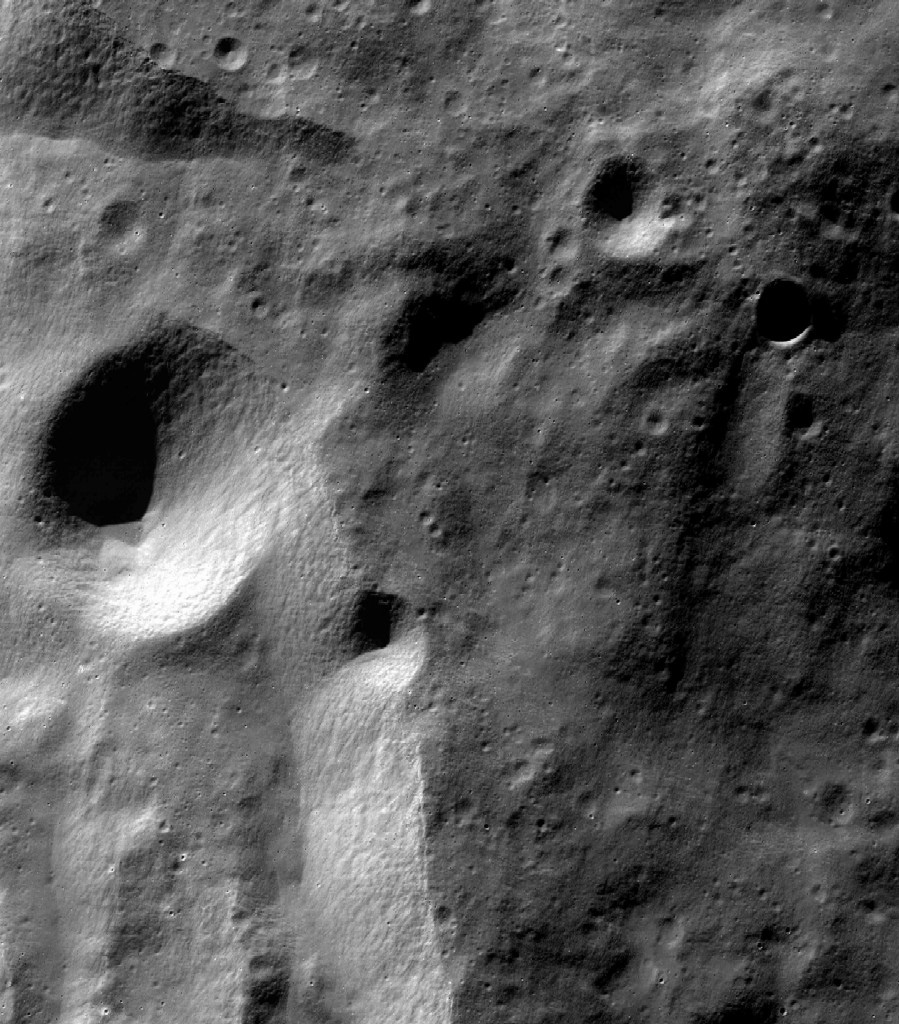
Picture of the lunar polar region taken by Chandrayaan-1's Terrain Mapping Camera (TMC) on 15 November 2008. Taken over the polar region of the moon, the picture shows many large and small craters. To the lower left, is the brightly-lit rim of 117 km-wide Moretus crater.
Credits: ISRO
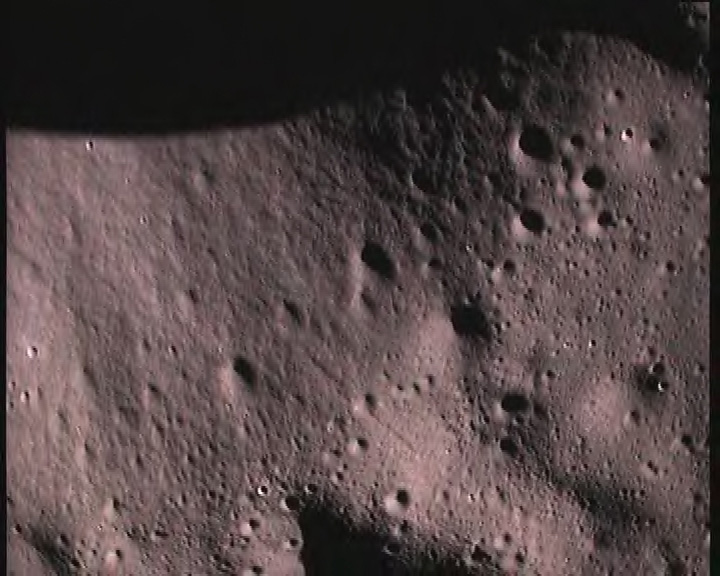
Raw image of the lunar surface taken by the camera of the Moon Impact Probe (MIP) on 14 November 2008 after separation from Chandrayaan-1.